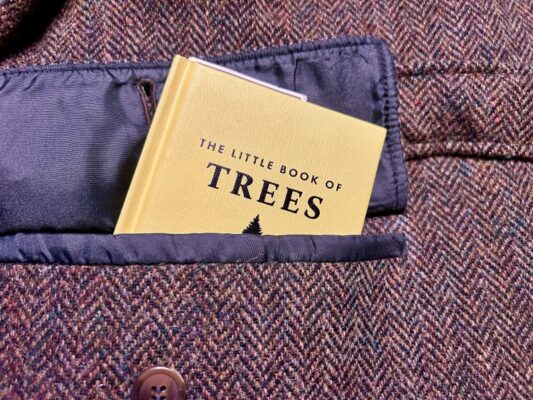Featured Book Review
Pocket-sized Mental Health Improvement Kits

Let’s be honest – even the most social media skeptical amongst us is vulnerable, should we find ourselves waiting in a particularly long queue, stuck in non-moving traffic, waiting for a coffee or a meal, etc. – to pulling out one of the ubiquitous little electronic time thieves that we carry about on our person each day, tapping open Insta-Book-Red-Tok, and allowing our attention to be diverted while our cognitive abilities and mental health are slowly degraded. It’s difficult not to fall into this trap. Indeed, it’s designed to be that way as there are billions of dollars to be made by causing every man, woman, and child on the planet capable of seeing a screen to develop an addiction to the use of social media through the Pavlovian conditioning of those using it by leveraging with each scroll the user’s own hypothalamus to release dopamine, explained by this article from Mass General Brigham McLean Hospital as “a ‘feel-good chemical’ linked to pleasurable activities such as sex, food, and social interaction.” As the article continues “the platforms are designed to be addictive and are associated with anxiety, depression, and even physical ailments.” More than perhaps any other modern business, social media companies have proven very well that if you aren’t paying a company for a service you think you are receiving, you’re not the customer; you’re the product.
Fortunately, we haven’t – yet – quite reached the Orwellian stage where the use of social media is both mandatory and enforced, although given the rapid demise of traditional forms of mass communication such as newspapers, magazines, broadcast television, and radio this may not be necessary as most of use may very well be “willing” (scare quotes added to emphasize the difficulty in ascribing free will to anyone acting under the effects of a chemical addiction) to do so rather than need to be made to comply. Myself, to borrow from Mr. Thomas, I’m not quite ready to go gently into that good mental night. In fact, I make it a practice of raging – quietly, admittedly – against the dying of the intellectual light by ensuring that I have a small book with me at all times when I’m away from home. Preferably pocket sized, these books have, over the course of this my journey, most commonly been from the Oxford World’s Classics, Oxford Very Short Introductions, and – when I can find well-preserved copies of them here in the former colonies far from their original country of publication – the Observer’s’ Book series. However, recently to these stalwart tools of intellectual and mental health defense, I have added the volumes of the Princeton Little Books of Nature series.
Newly Noted Books
Megalodons, Mermaids, and Climate Change

Megalodons and mermaids! Upon opening the package that contained a copy of the newly published book “Megalodons, Mermaids, and Climate Change; Answers to Your Ocean and Atmosphere Questions” by Dr. Ellen Prager and Dave Jones, I immediately thought how superbly appropriate the beginning of the title would be to have been included in Captain Nancy Blackett’s collection of colourful and creative oaths.
Brand Antarctica

In just over two hundred years, Antarctica has gone from being a distantly seen, near-fictional place to becoming a tourism destination of choice. In her new book “Brand Antarctica; How Global Consumer Culture Shapes Our Perceptions of the Ice Continent,” Dr. Hanne Elliot Fønss Nielsen explores how this transformation occurred through the popular media and what the implications of such a media-generated understanding of it are.
Climate Change on Mountains

While there is no definitive way to determine if the Prussian polymath Alexander von Humbolt was truly the “last person who knew everything,” it is an appellation that has been justifiably used in reference to him sufficiently often to secure him a place in the finals of such a contest. Natural and moral philosopher, geographer, […]
The Natural History of Selborne (Oxford World’s Classics Hardback Collection)

As the date on which this brief essay will be published marks the three-hundred-and-fourth anniversary of the Rev. Gilbert White’s birth in 1720 at the very same location as the parish he so lovingly chronicled, it seems only appropriate to bring you news of the most recently published edition of his natural history classic epistolary book “The Natural History of Selborne.”
California Snakes

I have often in the past praised Heyday Books for the consistently high level of dedication they have shown to the natural history community in publishing particularly well-written and useful guidebooks to the plants, wildlife, and ecosystems of the U.S. state of California. Now, with the publication of “California Snakes and How to Find Them” I have yet another reason to do so.
Otter Country

In her recently published “Otter Country; An Unexpected Adventure in the Natural World,” noted nature writer Miriam Darlington explores the world of the otter as it is found in England, Scotland, and Wales.
Naturalist Classics
Back to Basics Through Black and White

After being rejected by four other publishers who thought the market for such a book was too small to be worth their time, when Roger Tory Peterson’s A Field Guide to the Birds: Giving Field Marks of All Species Found in Eastern North America was first published on 27 April 1934 by Houghton Mifflin in an initial printing of 2,000 copies, it sold out in two weeks. It has ever since reigned as the monarch of North American field guides, being still available in the seventh edition Peterson Field Guide To Birds Of Eastern & Central North America, now published by HarperCollins following Houghton Mifflin (Harcourts)’s sale of its trade publishing division and other assets to News Corp in 2021. But enough about the board room machinations of the present-day masters of the universe
While most bird watchers have almost certainly seen a copy of at least one of the printings of one of the editions of Peterson’s field guides to birds, many may not have seen a first edition of it. Unlike the present-day editions of the Peterson field guides, and most all new field guides in general, the first Peterson guide was noteworthy for the eloquent brevity of its text, and its black and white images. (For those interested, Houghton Mifflin published a reprint edition of this classic book in 1997 that while now out-of-print can still be found with regularity in shops selling used books.) These black and white images – both plates of Peterson’s paintings and line illustrations – were partly due to the economically-dictated limitation of such guidebooks of the time as color printing was far more expensive then than it is today.
Recent Featured Book Reviews
In Praise of Folly Brook

As I have been with many other authors and books that have since joined my favourites, I was introduced to the works of B.B., the pen name of Denys Watkins-Pitchford, MBE, by Melissa Harrison through By Ash, Oak, and Thorn, her homage to his book The Little Grey Men. For those unfamiliar with B.B., and since becoming aware of him and his works myself I am regularly surprised by how many aren’t. He was a particularly prolific author, artist, naturalist, and that increasingly rare personage, a countryman. He wrote and published scores of books of fiction – many for younger readers – and non-fiction, illustrated not only his own but those of others as well, studied art in both Paris and at the Royal College of Art in London, was art master at Rugby School for nearly two decades, and near the end of his life was honored with an MBE by Her Majesty Queen Elizabeth II. Yet whether in the country or the city, his love of the natural world was the guiding force of his life, as testified by his famous motto:
The wonder of the world
The beauty and the power,
The shapes of things,
Their colours, lights and shades,
These I saw.
Look ye also while life lasts.
The Marvelously Multifaceted Mr. Newton

Most of us likely first heard the name Isaac Newton when we were in primary school. For some, it may have been in a classroom; for others it may have been while viewing a television program – most likely a cartoon. However, in most all instances, I’d be willing to wager that the name was connected with a falling apple. As we grew, the caricature of the man in the long coat and knee-length breeches sitting beneath a tree and being brained by a falling pippin likely gave way to the image of Newton as an extremely intelligent man who did something with gravity and mathematics. This is where the story comes to a conclusion for most. Yet for those of us who remained interested in science or theology – yes, theology – details of Newton’s life continued to emerge and enlarge our image of him. The tricky part is that the more details that became known to us, the more confused we were likely to become as at a particular point they seem to describe not a single person but two, perhaps even three – all of whom would too easily be thought today to be polar opposites to one another.
Of Interest
The HPS Podcast – Erika Milam on Colloquial Science

A new (to me) podcast was recently added to my regular listening rota: “The HPS Podcast.”
For the Love of Weather: Interview with Zoë Johnson

One of the podcasts I’ve begun listening to relatively recently is Gemma Plumb’s and Aisling Creevey’s For the Love of Weather. Both meteorologists with years of experience in the field, the podcast is the duo’s genuine labor of love for the title subject.
The Ship Report: Recent Natural History Themed Episodes

There aren’t many days that a new episode of Joanne Rideout’s The Ship Report podcast is published that I don’t include listening to it in the activities that begin my day. Not only does it remind me of the town in which I was raised, it often contains interesting information about the natural history of the lower Columbia River.
Enchanted: The Red Branch

Over the past few years I’ve found much to appreciate in Dr. Corinne Wieben’s podcast Enchanted; the History of Magic & Witchcraft, particularly when she takes up an aspect of the natural world.
The Well-read Naturalist does not maintain a Twitter (“X”) profile.
Any profile on that platform claiming to be published by or representing The Well-read Naturalist should be considered fraudulent and promptly reported to the platform moderators and The Well-read Naturalist in order that cease and desist actions may be undertaken.
